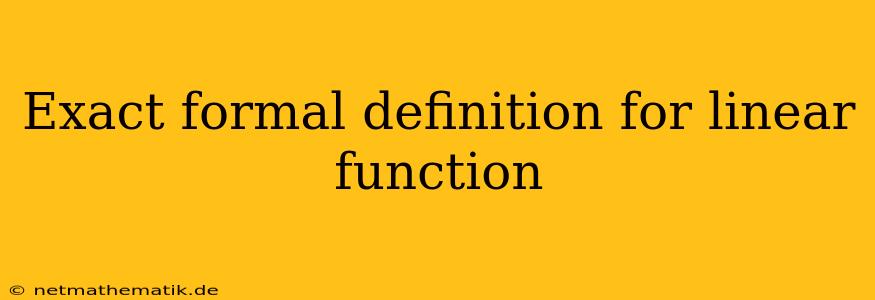The concept of a linear function is fundamental in mathematics, particularly in algebra and calculus. It represents a relationship between two variables where the change in one variable is directly proportional to the change in the other. This proportionality is characterized by a constant factor, known as the slope. To understand the concept fully, it's crucial to delve into the exact formal definition of a linear function.
Defining a Linear Function
A linear function is defined as a function whose graph is a straight line. This implies that the rate of change between any two points on the graph is constant. In other words, the function can be represented by a polynomial equation of the first degree.
Mathematically, a linear function can be expressed in the following forms:
1. Slope-Intercept Form:
The most common form is the slope-intercept form:
f(x) = mx + c
where:
- f(x) is the dependent variable, representing the output of the function.
- x is the independent variable, representing the input of the function.
- m is the slope, representing the rate of change of the function.
- c is the y-intercept, representing the value of the function when x = 0.
2. Point-Slope Form:
The point-slope form is derived from the slope-intercept form and is useful when a point on the line and the slope are known.
**y - y₁ = m(x - x₁) **
where:
- **(x₁, y₁) ** is a known point on the line.
- m is the slope.
3. Standard Form:
The standard form is used for expressing linear equations in a concise manner:
Ax + By = C
where:
- A, B, and C are constants.
- A and B are not both zero.
Characteristics of Linear Functions
Several key characteristics define a linear function:
-
Constant Rate of Change: As mentioned earlier, a linear function has a constant rate of change, represented by the slope. This means that for every unit change in the input (x), the output (y) changes by a fixed amount.
-
Straight Line Graph: The graph of a linear function is always a straight line. This visual representation helps to understand the constant rate of change and the direct proportionality between the variables.
-
One Independent Variable: Linear functions are defined by a single independent variable. This variable can be any real number, and its corresponding output will be determined by the function's equation.
Applications of Linear Functions
Linear functions find extensive use across various fields, including:
- Physics: In physics, linear functions are used to model motion with constant velocity, relationships between force and displacement, and other physical laws.
- Economics: In economics, linear functions are applied to model demand curves, supply curves, and production costs.
- Computer Science: Linear functions are used in computer algorithms, such as linear regression and linear programming.
- Engineering: Engineers use linear functions to model relationships between variables in structural analysis, fluid mechanics, and other engineering disciplines.
Examples of Linear Functions
1. Temperature Conversion:
The relationship between Celsius (°C) and Fahrenheit (°F) is a linear function:
F = (9/5)C + 32
This equation demonstrates that for every 1°C increase, the temperature in Fahrenheit increases by (9/5) degrees.
2. Distance and Time:
If you are traveling at a constant speed, the distance you travel is a linear function of time:
d = vt
where:
- d is the distance.
- v is the constant speed.
- t is the time.
3. Income and Hours Worked:
If you are paid an hourly rate, your income is a linear function of the number of hours you work:
I = wh
where:
- I is your income.
- w is your hourly rate.
- h is the number of hours worked.
4. Sales and Commissions:
Suppose you are a salesperson who earns a base salary plus a commission on sales. Your total income is a linear function of your total sales:
T = b + sc
where:
- T is your total income.
- b is your base salary.
- s is your commission rate.
- c is your total sales.
Conclusion
The linear function is a fundamental mathematical concept that describes a relationship between two variables with a constant rate of change. It finds applications in various fields, offering a simple and powerful tool for modeling real-world phenomena. Understanding the exact formal definition and characteristics of a linear function is crucial for comprehending its role in mathematics and other disciplines.
